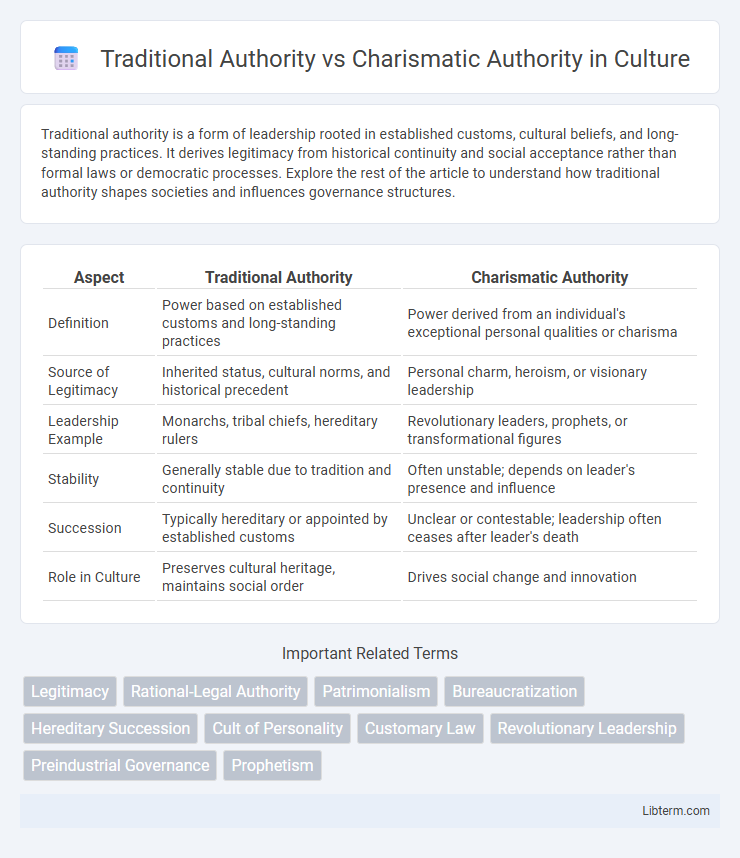Traditional authority is a form of leadership rooted in established customs, cultural beliefs, and long-standing practices. It derives legitimacy from historical continuity and social acceptance rather than formal laws or democratic processes. Explore the rest of the article to understand how traditional authority shapes societies and influences governance structures.
Table of Comparison
| Aspect | Traditional Authority | Charismatic Authority |
|---|---|---|
| Definition | Power based on established customs and long-standing practices | Power derived from an individual's exceptional personal qualities or charisma |
| Source of Legitimacy | Inherited status, cultural norms, and historical precedent | Personal charm, heroism, or visionary leadership |
| Leadership Example | Monarchs, tribal chiefs, hereditary rulers | Revolutionary leaders, prophets, or transformational figures |
| Stability | Generally stable due to tradition and continuity | Often unstable; depends on leader's presence and influence |
| Succession | Typically hereditary or appointed by established customs | Unclear or contestable; leadership often ceases after leader's death |
| Role in Culture | Preserves cultural heritage, maintains social order | Drives social change and innovation |
Understanding Authority: Definitions and Types
Traditional authority derives legitimacy from established customs, cultural norms, and inherited status, often grounded in long-standing social structures such as monarchies or tribal leadership. Charismatic authority hinges on an individual's exceptional qualities, vision, or heroism that inspire devotion and obedience, exemplified by revolutionary leaders or influential prophets. Understanding these distinct types highlights how societies legitimize power through either historical continuity or personal appeal, shaping governance and social cohesion.
Overview of Traditional Authority
Traditional authority is a form of leadership rooted in established customs, cultural practices, and long-standing social structures, where legitimacy is inherited or passed down through generations. It relies heavily on the preservation of historical continuity and the acceptance of authority as part of societal norms. Examples include monarchies, tribal chieftaincies, and feudal systems where obedience is owed to figures recognized by tradition rather than personal qualities.
Characteristics of Traditional Authority
Traditional Authority is defined by established customs, rituals, and long-standing societal structures where legitimacy stems from historical precedent and inherited status. This form of authority relies heavily on the continuity of tradition, often embodied by monarchs, tribal chiefs, or elders who wield power based on lineage and cultural acceptance rather than personal qualities. Stability and resistance to change are key characteristics, as the authority is maintained through deep-rooted social norms and collective belief in the sanctity of time-honored practices.
Overview of Charismatic Authority
Charismatic authority derives from the personal charm and extraordinary qualities of a leader, inspiring devotion and obedience from followers. Max Weber identified it as a form of leadership based on perceived exceptional sanctity, heroism, or exemplary character, which commands loyalty beyond legal or traditional norms. This authority is inherently unstable, depending on the leader's ability to maintain their charismatic appeal and often leading to institutionalization or decline after their tenure.
Key Traits of Charismatic Authority
Charismatic authority is defined by the personal charm, magnetic personality, and exceptional leadership qualities of an individual, inspiring devotion and obedience from followers. It relies on the perception of extraordinary qualities and the ability to enact radical change, often emerging during times of crisis or social upheaval. Unlike traditional authority based on established customs or lineage, charismatic leaders derive power from their unique vision and emotional appeal.
Historical Examples of Traditional Authority
Historical examples of traditional authority include monarchies such as the British Empire under Queen Victoria, where power was inherited through established customs and lineage. Feudal Japan exemplifies traditional authority with its rigid hierarchical system led by samurai and shoguns maintaining power through inherited status and rituals. These societies relied on long-standing cultural norms and hereditary succession to legitimize leadership and maintain social order.
Famous Figures of Charismatic Authority
Charismatic authority is exemplified by famous figures such as Martin Luther King Jr., Mahatma Gandhi, and Joan of Arc, whose personal qualities inspired devotion and social change. Unlike traditional authority, which relies on established customs and inherited power, charismatic leaders gain influence through exceptional personal charm, vision, and leadership skills. Their ability to mobilize masses and challenge existing structures often leads to groundbreaking transformations in society and politics.
Strengths and Weaknesses: A Comparative Analysis
Traditional Authority derives strength from established customs and deep-rooted cultural legitimacy, promoting social stability and continuity, but it often resists change and may perpetuate outdated practices. Charismatic Authority thrives on the personal appeal and vision of a leader, inspiring rapid mobilization and innovation, yet it risks instability due to dependency on the leader's presence and may decline swiftly after their departure. Both authorities play critical roles in governance and social organization, but their effectiveness depends on context, with traditional authority favoring consistency and charismatic authority enabling transformative leadership.
Social Impact and Stability of Each Authority
Traditional authority, rooted in long-established customs and hereditary succession, promotes social stability by reinforcing existing norms and continuity within communities. Charismatic authority, based on the personal appeal and extraordinary leadership qualities of an individual, can inspire rapid social change but often lacks long-term stability due to its dependence on the leader's presence. Social impact under traditional authority tends to preserve hierarchical structures and collective identity, whereas charismatic authority mobilizes followers towards transformative goals, sometimes leading to social upheaval or institutional shift.
The Transition Between Traditional and Charismatic Authority
The transition between traditional and charismatic authority occurs when legitimate power shifts from established customs and hereditary rule to the personal appeal and extraordinary qualities of an individual leader. This change often emerges during periods of social crisis or upheaval when people seek new sources of leadership beyond traditional norms. As charismatic authority gains influence, it can redefine societal values and structures, challenging and potentially transforming longstanding traditional institutions.
Traditional Authority Infographic

 libterm.com
libterm.com